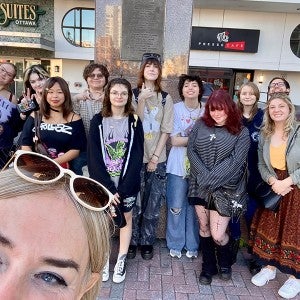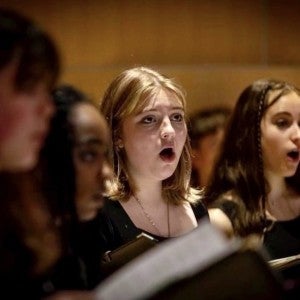The making of a very different 'Collage'
Students, faculty, and staff pivot and innovate to continue the Arts Academy's popular multidisciplinary showcase during the pandemic.
There’s nothing quite like “Collage.” Each fall, for the past 40 years, Interlochen Arts Academy’s traditional fall showcase of student artwork and performances draws hundreds of students, faculty and staff, and friends of Interlochen to Corson Auditorium for a whirlwind evening of music, theatre, dance, film, creative writing, and visual art.
But this year, with the Interlochen campus closed to the public and students and faculty following strict social distancing protocols, “Collage” could not be presented in its traditional format. Instead, faculty, administrators, and students adapted the production for pandemic times.
“So much has been upended by the pandemic—from our mundane daily routines to our cherished, shared concerts and celebrations,” said Dane Philipsen, instructor of oboe and chair of woodwinds. “But there is also a very real opportunity for the Interlochen community to examine our artistic practices and thoughtfully participate in this greater societal experience.”
Inspired by the success of May’s virtual Arts Academy Festival, “Collage” 2020 was conceived as a live video event that combined 28 pre-recorded segments into a fast-paced multidisciplinary showcase. Students and on-campus staff gathered together (physically distanced) at Kresge Auditorium to enjoy the resulting video on Sept. 25. For the first time ever, “Collage” was also streamed at live.interlochen.org and on Facebook, enabling friends of Interlochen from around the world to tune in to this vibrant tradition.
Planning Ahead, Minimizing Risk
The work of creating “Collage” began long before students set foot on campus. Over the summer, faculty and health services staff followed the latest research on the transmission of virus particles, particularly in the context of singing and playing wind instruments. This research was critical not only for the success of “Collage,” but also for setting protocols for day-to-day classes and rehearsals.
“We’ve been focusing on the aerosols that we emit, particularly when singing loudly or with enthusiastic diction,” said Laura Osgood-Brown, instructor of voice and opera workshop. “We mitigate risk factors through precautions like singing with masks and maintaining appropriate physical distancing.”
Faculty and students are also minimizing risk through technology. For example, many private music lessons take place through a dual room set-up. Hard lines carry audio and video information between the two rooms with almost imperceptible latency, enabling collaboration in real time.
Technology also facilitated the audition process for this year’s “Collage.” Instead of auditioning through live screenings, students were asked to submit recordings.
New Opportunities for Learning
Many faculty members, students, and staff found that this year’s “Collage” fostered unexpected avenues for learning and discovery.
“Collage” challenged theatre students to perform while masked during their first performance of this unusual year. “The big challenge for us was helping the students articulate clearly through their masks and making sure that their thoughts and emotions could be fully expressed to the viewer,” said Bill Church, director of theatre. “Taking away a significant portion of an actor’'s face requires that other tools be utilized more effectively to bring a performance to life.”
For Osgood-Brown, significant learning took place during her students’ recordings sessions. “I spent a lot of time helping students learn how to make their own recordings, which is not something we have focused on as much in the classical music program,” she said. “We talked about every aspect of making the recording, from how to prepare to what the camera angle should look like. It was an important educational process.”
Once the student performers were selected, the process of recording individual acts began. Each segment was filmed on the stage of Corson Auditorium following the Academy’s rigorous COVID-19 protocols, with ensemble performers spaced six feet apart and all performers, instructors, and crew wearing masks.
“A socially distant ‘Collage’ did come with its fair share of challenges, but we also were able to showcase the student work in a way that has never been done before,” said Brent Wrobel, director of Interlochen Presents, the team that manages live performances and events.
For the Presents crew, planning a digital performance was also a learning experience. “We had to employ a degree of technology that was new to many of us,” said Alexandra Herryman, a stage services coordinator. “We learned about lighting for camera, camera placement, and most importantly, creating a dynamic show without the thrill of an audience full of people.”
The production for each piece was carefully designed to help the viewer at home feel connected to the students and their hard work. “The multi-camera setup allowed us to go from a wide shot, providing the viewer with the context of the performer on Corson’s stage, to a close-up, such as fingers moving up and down the keys of the piano,” Wrobel said. “Because each piece was recorded individually, we were able to perform several takes in order to ensure the best student performance as well as high-quality production value.”
Recording multiple takes also provided a learning opportunity for students. “I was able to be there with the students during their recording session,” Osgood-Brown said. “After a few times through the piece, we would listen to the takes together. Those discussions helped develop their critical ear and taught them vocabulary with which to discuss the qualities of different takes.”
For Philipsen, recording sessions were an opportunity to teach a different set of performance skills. “For performing artists, everything feels so different when that live connection is swapped for microphones and cameras,” he said. “The thrill—and butterflies—of having one chance to share a fleeting experience with others is different from the pressures we feel when recording a piece. But both experiences are important for artists in the 21st century.”
Gratitude All Around
With the recordings complete, the Presents team edited the performance together. The music, theatre, dance, interdisciplinary arts, and creative writing performances recorded in Corson Auditorium were punctuated by videos by film students and a slideshow of works by visual artists.
Despite the differences in format, the overwhelming emotion of students, faculty, and staff was gratitude.
“Watching all the talented people perform, one after another, was really inspiring,” said Abby Lewin, a senior classical voice major. “I am so grateful that even during this pandemic we were able to come together and find ways to make ‘Collage’ happen.”
Osgood-Brown agreed. “The heart of “Collage” was still there: sharing the learning, growing, and artmaking across disciplines. I’m just so grateful to be here with the students.”
“When I get to experience these live performances from my students and colleagues this year, it means more than ever,” Philipsen said. “I hope those of you on the virtual end of the audience experience can feel that energy coming through too.”









